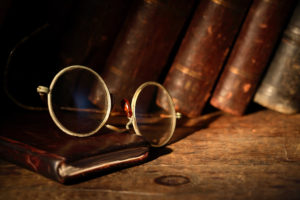
You probably know quite a few people who live with nearsightedness, or myopia. Maybe you even have it yourself! What many people don’t know is that myopia is increasing at an alarming rate. In fact, it is estimated that roughly 4.7 billion people will be myopic by 2050. That’s right – BILLION. That’s almost half of the global population!
Fortunately, we have many options available to correct cases of nearsightedness – like glasses, contact lenses and LASIK surgery! You won’t have to worry much about reading road signs or seeing your TV screen clearly. But what did people do before glasses and all of our other fancy correction methods?
The Prevalence of Myopia Over Time
It is important to note that nearsightedness was not always the big problem it is today. However, researchers and historians have reason to believe that as long as there have been humans, nearsightedness has probably existed.
Back in the day (we’re talking a couple million years ago), myopia was around, but was probably rare. Only in the past three centuries have we seen a skyrocket in the number of people with myopia. Many historians attribute this phenomenon to the rise in literacy – meaning that the more people starting reading (fixating on close objects for hours at a time), myopia rates rose in conjunction.
Nutrition and genes may also play a role in myopia, but it seems that education and myopia may be related. As more people started reading and learning from books, their eyes grew larger to help them better focus up close. Of course, this had some negative side effects – it made distance vision worse. Some ophthalmologists believe that dim light can exacerbate this effect.
Overall, people thousands of years ago probably squinted a lot less to see at a distance than people do today. So, what happened to the few who had myopia?
So, What Did People Do Without Glasses?
Well, nothing. They could not correct their vision without aid, but they probably capitalized on the fact that they could only see up close. These people were more than likely crafting skills that involved close, detailed work. Historians speculate that these people may have been more likely to create the fine engravings we find on ancient artifacts today. It is believed this detailed work may have benefited from a nearsighted craftsman.
The First Pair of Glasses and Beyond
If you were nearsighted in the 13th century, you would have (sort of) been in luck. The earliest known pair of glasses was invented in the 13th century in Italy. Soon, merchants started carrying glasses along the Silk Road to Asia. Because these were so hard to find, in Asia they were primarily available to the upper class, and often served as a status symbol. These glasses became common throughout Europe where they were produced.
These glasses worked, but they were very different from the glasses we wear today. You could not wear them on your face as they did not have anything to keep them on. They were primarily intended to help people read, not see far away. They were heavy and shatter prone.
Glasses for nearsightedness likely weren’t invented until the 15th century. Glasses during this time, however, did not gain much traction because they were seen as a sort of magical power (which, during this time, meant you were in league with the Devil.)
After the Reformation, once literacy and education became more common, people started wearing glasses more and more. Eventually, glasses that could be worn on the face were created. From there, styles, shapes, and materials became rapidly diversified and glasses became more accessible. That leads us to today!
Modern Vision Correction
In our modern society, students stay in school longer than ever before. Reading from computers, TV screens, and cell phones adds a whole set of new contributors. Because myopia rates rise as humans fixate on close objects (with no signs of stopping), and our technological revolution has no end in sight, our projected 2050 rate makes a lot of sense!
Luckily, we don’t only have to rely on glasses as a form of vision correction today. We have more options than ever, from contact lenses to LASIK to PRK and much more.
If you would like to take advantage of our modern technology to correct your nearsightedness, contact Loden Vision Centers at one of our conveniently located Tenessee offices today. We look forward to helping you achieve your vision goals!


